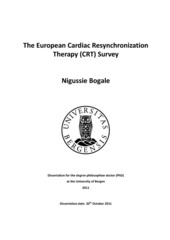The European Cardiac Resynchronization Therapy (CRT) Survey
Doctoral thesis
Permanent lenke
https://hdl.handle.net/1956/5688Utgivelsesdato
2011-10-20Metadata
Vis full innførselSamlinger
Sammendrag
Aims: The European Cardiac Resynchronization Therapy (CRT) Survey was a joint initiative taken by the Heart Failure (HFA) and the European Heart Rhythm (EHRA) Associations of the European Society of Cardiology (ESC) designed to evaluate the current implantation practice of Cardiac Resynchronization Therapy (CRT) in the participating countries. Methods: Patients who had a successful CRT implantation were enrolled from 141 centres in 13 countries between November 2008 and June 2009. The participating countries were Austria, Belgium, France, Germany, Ireland, Israel, Italy, the Netherlands, Norway, Spain, Sweden, Switzerland and UK. Baseline demographics, clinical and implantation data were collected using electronic case report form (eCRF) with a follow-up of approximately one year (9-15 months). Centres were divided into high and low volume categories and their patient selection and implantation practice was analysed. Outcomes in de novo implantations were compared to upgrades from permanent pacemakers (PPM) and implantable cardioverter defibrillators (ICDs). The follow-up data contained clinical outcomes including symptom severity, cardiovascular hospitalization and survival. Results: 2438 patients were enrolled and follow-up data acquired from 2111 patients (87 %). The population included important groups of patients poorly represented in randomized clinical trials (RCTs), including very elderly patients, those with prior device implantation, atrial fibrillation and QRS duration < 120 ms. Significantly more CRT implantation in patients with mild symptoms and narrow QRS width was reported at high volume centres. Similar improvement in New York Heart Association (NYHA) class, similar reduction in QRS duration and low and similar total and cause specific mortality was observed between upgrades and de novo implantations. Investigators reported substantial improvement in NYHA functional class at follow up and patients reported improvement in self-assessed global condition. During follow-up, 207 (10 %) patients died, 346 (16 %) were hospitalized and 501 (24 %) died or were hospitalized. NYHA functional class III/IV, atrial fibrillation, ischaemic aetiology and device type (CRT-P) were associated with poor survival. Predictors of CV hospitalization and the combined end point of CV hospitalization or mortality were NYHA functional class III/IV and atrial fibrillation. Women had a better outcome as did patients who had a CRT-D device. Conclusions: The CRT Survey provided important information describing current European implantation practice at the time of inclusion. High-volume centres were more explorative in their implantation practice than low-volume centres. Patients undergoing upgrades from existing devices (PPM and ICDs) had similar outcomes and complications rates compared to de novo implantations. Outcomes including death and hospitalization during 1 year followup in this European CRT survey were consistent with results from clinical trials of CRT. At one year follow-up, 81 % of patients who received a CRT device considered their symptoms improved compared to the pre-implant assessment. This is a prospective, observational study of successful CRT implantations and the results must be interpreted with appropriate conservatism.
Består av
Paper I: The CRT Survey Scientific Committee, corresponding author Bogale, N. European cardiac resynchronization therapy survey: rationale and design. European Journal of Heart Failure 11(3): 326-330, March 2009. Full text not available in BORA due to publisher restrictions. The article is available at: http://dx.doi.org/10.1093/eurjhf/hfp030Paper II: Dickstein K., Bogale N., Priori S., Auricchio A., Cleland J. G., Gitt A., et al. The European cardiac resynchronization therapy survey. European Heart Journal 30(20) :2450-2460, October 2009. . Full text not available in BORA due to publisher restrictions. The article is available at: http://dx.doi.org/10.1093/eurheartj/ehp359
Paper III: Bogale N., Priori S., Auricchio A., Cleland JG., Gitt A., Dickstein K., et al. The European CRT Survey: Patient selection and Implantation practice vary according to centre volume. EP-Europace 13(10): 1445-1453, June 2011. Full text not available in BORA due to publisher restrictions. The article is available at: http://dx.doi.org/10.1093/europace/eur173
Paper IV: Bogale N., Witte K., Priori S, Cleland J. G., Auricchio A., Gitt A., et al. The European CRT Survey: Comparison between upgraded and de novo cardiac resynchronization therapy implantations. European Journal of Heart Failure 13(9) :974-983, July 2011. Full text not available in BORA due to publisher restrictions. The article is available at: http://dx.doi.org/10.1093/eurjhf/hfr085
Paper V: The European CRT Survey: 1 year follow-up results. Bogale N., Priori S., Cleland JG., Brugada J., Linde C., Auricchio A., et al. European Journal of Heart Failure 2011 14 (1): 61-73, 2012. Full text not available in BORA due to publisher restrictions. The article is available at: http://dx.doi.org/10.1093/eurjhf/hfr158
